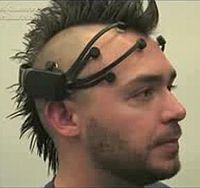
Thought identification
Encyclopedia

Neuroimaging
Neuroimaging includes the use of various techniques to either directly or indirectly image the structure, function/pharmacology of the brain...
has provided some early demonstrations of the technology's potential to recognize high-order patterns in the brain. In some cases, this provides meaningful (and controversial) information to investigators.
Professor of Neuropsychology
Neuropsychology
Neuropsychology studies the structure and function of the brain related to specific psychological processes and behaviors. The term neuropsychology has been applied to lesion studies in humans and animals. It has also been applied to efforts to record electrical activity from individual cells in...
, Barbara Sahakian, qualifies "A lot of neuroscientists in the field are very cautious and say we can't talk about reading individuals' minds, and right now that is very true, but we're moving ahead so rapidly, it's not going to be that long before we will be able to tell whether someone's making up a story, or whether someone intended to do a crime with a certain degree of certainty."
Identifying thoughts
When humans think of an object, like a screwdriver, many different areas of the brain activate. This is because what we call MemoryMemory
In psychology, memory is an organism's ability to store, retain, and recall information and experiences. Traditional studies of memory began in the fields of philosophy, including techniques of artificially enhancing memory....
is actually distributed associations throughout the brain - using the screwdriver, seeing the screw driver, etc. Psychologist Marcel Just
Marcel Just
Marcel Just is D. O. Hebb Professor of Psychology at Carnegie Mellon University. His research uses brain imaging in high-level cognitive tasks to study the neuroarchitecture of cognition. Just's areas of expertise include psycholinguistics, object recognition, and autism, with particular...
and his colleague, Tom Mitchell, have used FMRI brain scans to teach a computer to identify the various parts of the brain associated with specific thoughts.
This breakthrough technology also yielded a discovery: similar thoughts in different human brains are surprisingly similar neurologically. To illustrate this, Just and Mitchell used their computer to predict, based on nothing but FMRI data, which of several images a volunteer was thinking about. The computer was 100% accurate, but so far the machine is only distinguishing between 10 images.
Psychologist John Dylan-Haynes explains that FMRI can also be used to identify recognition in the brain. He provides the example of a criminal being interrogated about whether he recognizes the scene of the crime or murder weapons. Just and Mitchell also claim they are beginning to be able to identify kindness, hypocrisy, and love in the brain.
In 2011, a team led by Shinji Nishimoto used only brain recordings to partially reconstruct what volunteers were seeing. The researchers applied a new model, about how moving object information is processed in human brains, while volunteers watched clips from several videos. An algorithm searched through thousands of hours of external youtube video footage (none of the videos were the same as the ones the volunteers watched) to select the clips that were most similar.. The authors have uploaded demos comparing the watched and the computer-estimated videos..
Predicting intentions
Some researchers in 2008 were able to predict, with 60% accuracy, whether a subject was going to push a button with their left or right hand. This is notable, not just because the accuracy is better than chance, but also because the scientists were able to make these predictions up to 10 seconds before the subject acted - well before the subject felt they had decided. This data is even more striking in light of other research suggesting that the decision to move, and possibly the ability to cancel that movement at the last second, may be the results of unconscious processing.John Dylan-Haynes has also demonstrated that FMRI can be used to identify whether a volunteer is about to add or subtract two numbers in their head.
Brain as input device

Emotiv Systems
Emotiv Systems is an Australian electronics company developing brain–computer interfaces based on electroencephalography technology. The company was founded in 2003 by four scientists and executives: neuroscientist Professor Allan Snyder, chip-designer Neil Weste, and technology entrepreneurs Tan...
, an Australian electronics company, has demonstrated a headset that can be trained to recognize a user's thought patterns for different commands. Tan Le demonstrated the headset's ability to manipulate virtual objects on screen, and discussed various future applications for such brain-computer interface devices, from powering wheel chairs to replacing the mouse and keyboard.
Ethical issues
With brain scanningNeuroimaging
Neuroimaging includes the use of various techniques to either directly or indirectly image the structure, function/pharmacology of the brain...
technology becoming increasingly accurate, experts predict important debates over how and when it should be used. One potential area of application is criminal law. Haynes explains that simply refusing to use brain scans on suspects also prevents the wrongly accused from proving their innocence.

